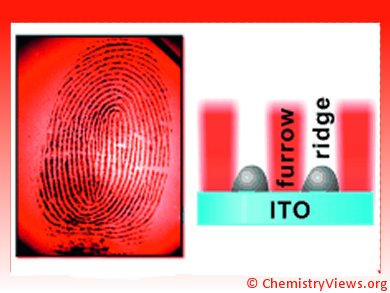Electrochemiluminescent Fingerprint Visualization
Fingerprints are not just important in forensics and the identification of people; they can also be used for security clearance, access control, and the authentication of documents. In the journal Angewandte Chemie, Chinese researchers have now introduced a new fast method to make fingerprints visible at high resolution.
Fingerprints consist of sweat, oil, and compounds picked up from the environment. Latent fingerprints are often not identifiable with the naked eye; but many methods have been developed to make them visible. A team led by Bin Su at Zhejiang University, Hangzhou, China, has now added another interesting method to the mix. Their process is based on electrochemiluminescence.
Electrochemiluminescence consists of the following phenomenon: application of an electric voltage causes electrons transferred to an electrode from a chemical compound, such as a ruthenium complex, which further reacts with a partner, typically tripropylamine. The product formed is in an electronically excited state; it returns to its ground state by giving off light.
The researchers use a small glass plate coated with indium tin oxide or just a piece of stainless steel plate as the electrode. A fingerprint is transferred to this plate and then a solution containing the reactants is added. In the places where the fat-containing components of the fingerprint cover the plate, the electrode is inactive; the electrochemical reaction cannot take place, and no light is emitted. This produces a negative image of the fingerprint that can be recorded with a CCD camera.
Simple and Non-destructive Technique
This direct, fast, and simple method makes both fresh and old fingerprints visible without destroying them. The fingerprints are so well-resolved that it is possible to make out not only the ridge pattern, but also fine details like the branching and ends of lines, and even the tiniest features, like the distribution of pores in the grooves. These details are helpful in the identification of incomplete fingerprints. No complex procedures are needed to prepare the sample. In addition, there is no vapor or dusting involved for the user, unlike in many conventional processes.
Electrochemiluminescence can also be used in a second mode, which shows the fingerprint as a positive image. In this case, the fingerprints are first treated with a reagent that binds to components of the fingerprints. After the reaction partners are applied, only the lines emit light. This mode could be a starting point for the development of methods to detect drugs and other substances that the person who made the prints either ingested or came into contact with.
Image: © Wiley-VCH
- Imaging Latent Fingerprints by Electrochemiluminescence,
Linru Xu, Yan Li, Suozhu Wu, Xianghong Liu, Dr. Bin Su,
Angew. Chem. Int. Ed. 2012.
DOI: 10.1002/anie.201203815



